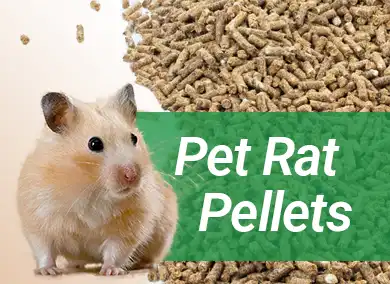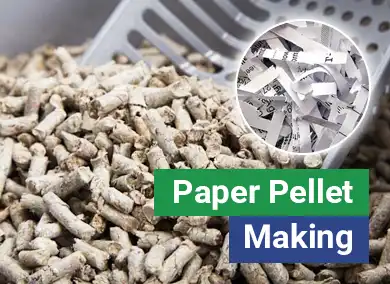India is one of the world's largest producers of eggs and broiler chickens. As of 2024, the country produces over 140 billion eggs and around 4.5 million tons of chicken meat every year. The poultry industry is already worth $30.46 billion and continues to grow rapidly.
With expanding production, the market is expected to reach around $66.37 billion by 2034-showing strong growth potential.
Starting a simple and profitable chicken farm in India is a realistic opportunity. If managed well, it can provide a steady source of income. This guide will walk you through the key steps to get started.
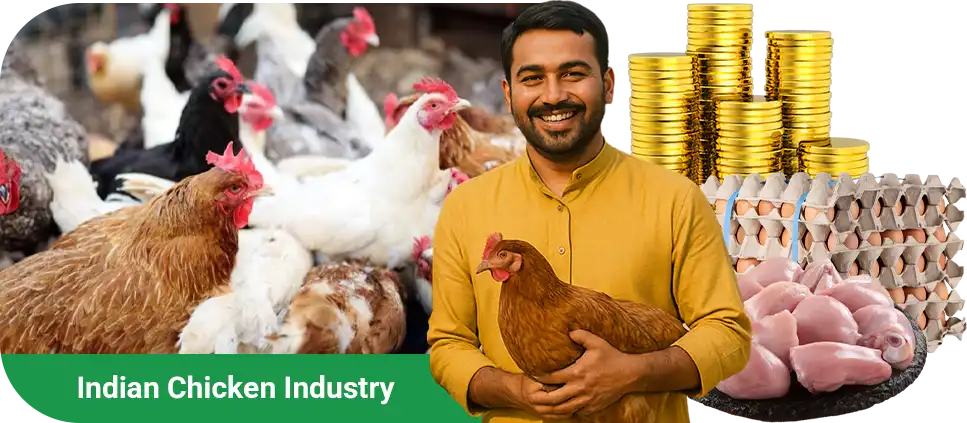
1.Learn About Loan and Subsidy Programs
To support the growth of poultry farming, both the central and state governments in India offer various loans and subsidies.
Central Government Support: NABARD Poultry Venture Capital Fund
This program is part of the government's "Entrepreneurship Development and Employment Generation" scheme, managed by NABARD (National Bank for Agriculture and Rural Development). It offers interest-subsidized loans that are later converted into direct subsidies.
The subsidy rate depends on factors like the size of the farm, location, and the applicant's background. For eligible applicants from special regions or disadvantaged groups, the subsidy can cover up to 33.33% of the project cost.
However, you'll need to contribute at least 10% of the total cost yourself. The rest can be financed through a bank loan.
State-Level Subsidy Programs
Many state governments also offer special subsidies or incentives for local poultry farmers. For example, Maharashtra has run a subsidy program since 2013 to support the setup of broiler farms with a capacity of 1,000 birds.
The funding helps cover infrastructure costs, such as constructing standardized chicken sheds. Depending on the applicant's category, the subsidy ranges from ₹112,500 to ₹168,750.
PM SVANidhi Scheme
The PM SVANidhi scheme is a micro-loan program launched by the Indian government to help street vendors restart their businesses. It is still active and has been expanded over time.
The program offers unsecured loans in stages. Borrowers can start with ₹10,000, and if they repay on time, they can apply for ₹20,000 and later ₹50,000. In addition, borrowers receive a 7% interest subsidy each year.
(This information is current as of April 2025. Please check with local authorities for any updates before you start.)

2.Understand the Chicken Farming Market in India
Once you're familiar with the available funding options, the next step is to choose a chicken farming method that suits your goals and fits the local market.
In India, chicken farming is mainly divided into two types: broiler farming and layer farming.
Broiler Chicken Farming
Broiler farming focuses on raising chickens for meat. Compared to other types of chicken farming, it's more popular because of its higher profit potential and shorter growing cycle. Broilers typically reach market weight in 6 to 7 weeks. Many farms sell their chickens to local markets or meat suppliers.
In traditional or region-specific farming, popular native breeds include:
Aseel, Kadaknath, Chittagong, Nicobari, and Jaggus. These chickens are known for their rich meat quality and strong adaptability.
In commercial farming, fast-growing breeds such as:
Krishibro, Avian, Hubbard, and Cobb are widely used. They have shorter growing periods and reach market weight quickly.
Major broiler-producing states: West Bengal, Maharashtra, Tamil Nadu, Telangana, Uttar Pradesh, Haryana, and Andhra Pradesh.
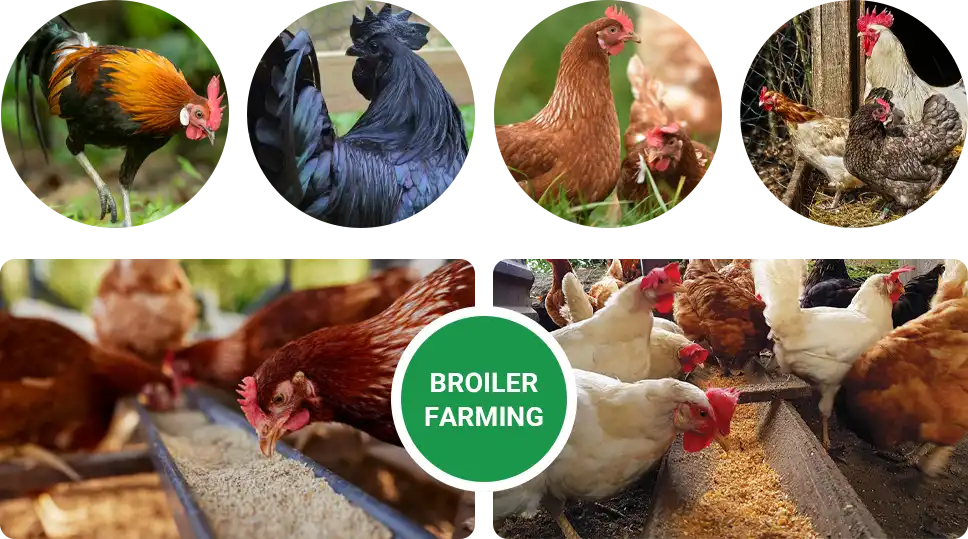
Layer Chicken Farming
Layer farming focuses on egg production. Most hens lay eggs between 18 and 78 weeks of age. To maintain good productivity, it's important to closely manage their environment and overall health. Egg production usually begins to decline after 78 weeks.
Some commonly raised native breeds are:
| Breed | Annual Egg Production | Key Features |
| Upkari & subtypes | 170–300 eggs | Heat-tolerant |
| Lokhen | ~250 eggs | Common in regional farming |
| Orpington | ~200 eggs | Dual-purpose breed |
| Rhode Island Red | 250–255 eggs | Lays brown eggs |
| Australorp | 300+ eggs | Lays brown eggs |
Common commercial egg-laying breeds include:
| Breed | Eggs by 72 Weeks | Key Features |
| Hy-Line Brown | 320–330 eggs | High productivity |
| Lohmann Brown | 300–315 eggs | Widely used in industry |
| ISA Brown | ~313 eggs | Consistent performance |
Major egg-producing states in India include: Andhra Pradesh, Tamil Nadu, Telangana, West Bengal, and Karnataka.
You'll notice that many of the broiler and layer farming states overlap. This is mainly because these regions offer favorable climates, abundant agricultural resources, and strong market demand-giving them a clear advantage in both types of chicken farming.
With these advantages in place, you can choose the right breed and farm size based on your goals and budget.
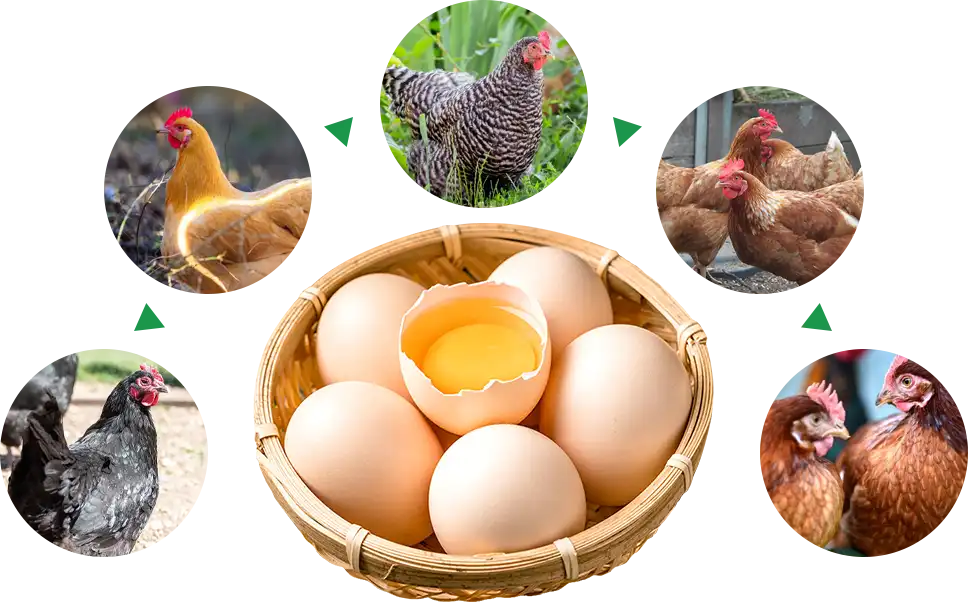
3.Create a Basic Chicken Farming Business Plan
To keep your farm running smoothly, it's important to have a solid plan before you get started. Your business plan should include:
Location: Describe the planned location of your farm. Ensure it is suitable in terms of accessibility, water and electricity supply, and biosecurity. A simple layout of the farm is recommended.
Housing: Specify the type of housing system (deep litter or cage system). Mention design details like ventilation, space per bird, and lighting setup.
Equipment: List the essential equipment needed, such as feeders, drinkers, brooders, lighting systems, cages, egg trays, and a generator.
Chick Sourcing: State where you will purchase your chicks. Make sure they come from a reputable hatchery.
Feed Management: Mention the types of feed (starter, grower, broiler or layer feed), your feed source (store-bought or self-prepared), estimated feed consumption, and your storage method.
Health and Vaccination: Include a vaccination schedule, disease prevention plans (especially biosecurity), and access to veterinary support.
Labor: Estimate how many workers you'll need and outline their main responsibilities.
Marketing and Sales Strategy: Describe how you plan to price your products and attract customers, whether through local advertising, social media, or direct sales.
4.Choose a Suitable Farm Location
Choosing the right location is the first step toward successful chicken farming. Ideally, the farm should be away from residential areas to reduce pollution and disease risk, but still close enough to markets for easy sales and transportation. Good road access, reliable water and electricity supply, and proper drainage are also essential.
Once you've chosen the site, you'll need to plan the space carefully. A basic layout usually includes:
- Ground area for the chickens to move around
- Space for feeders
- Space for drinkers
- Clear pathways for access and cleaning
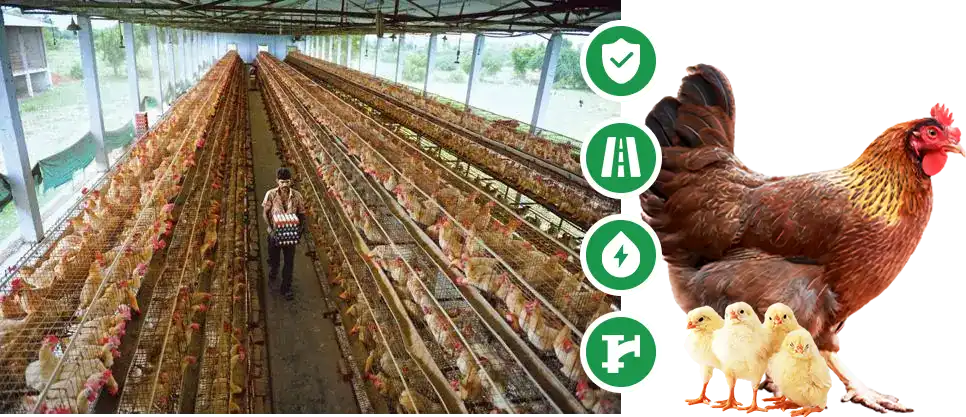
5.Register the Required Licences
Once your farm layout and location are set, the next step is to make sure your project complies with local regulations. This means registering the necessary licences and permits to operate your business legally.
| Type of Licence/Registration | Purpose |
| GST Registration | Legally registers your business and allows you to charge customers tax. |
| Trade Licence | Required by central or state authorities to operate a poultry business in a specific area. |
| FSSAI Licence | Certifies that your poultry products meet food safety and hygiene standards. |
| NOC from the Local Village Panchayat | Proof of no objection from local authorities or village council. |
| Pollution Certificate (PUC) | Confirms your facilities or vehicles meet air pollution standards. |
| IEC Code | Importer Exporter Code, needed for international trade. |
| EPF Registration | Registers you as an employer under the Employee Provident Fund scheme. |
| Trademark | Protects your brand name, logo, or product identity. |
| MSME/SSI Registration | Needed to access government support, subsidies, and benefits for small or medium-sized poultry farms. |
6.Cost of Starting a Chicken Farm
After completing your basic planning, the next step is to estimate how much startup capital you'll need.
For example, here's a basic cost breakdown for a small broiler farm with 1,000 chickens:
Land: Many farmers prefer to lease land at the beginning to reduce capital costs.
Housing: A deep litter poultry house costs ₹250–₹450 per square foot; since each bird needs around 1–1.5 sq ft, 1,000 birds require about 1,500 sq ft, bringing the total to ₹375,000–₹675,000.
Equipment: Feeders, drinkers, brooders, lighting, and tools usually cost ₹50,000–₹100,000.
Chicks: At ₹35–₹55 per chick, the cost for 1,000 chicks is around ₹35,000–₹55,000; layer chicks may be more expensive.
Feed and Medicines: Feed for one cycle costs ₹100–₹130 per bird (₹100,000–₹130,000 total), plus ₹5,000–₹10,000 for medicines and vaccines.
Utilities: Installing water and electricity systems, including deposits, costs ₹20,000–₹50,000.
Licences and Miscellaneous: Permits and other expenses may add ₹10,000–₹25,000.
Working Capital: It's wise to reserve ₹50,000–₹100,000 to fund your next production cycle.
Estimated Total: ₹640,000–₹1,145,000, not including land rent or labor costs.
7.Estimate Your Return on Investment
Let's take a simple example based on 1,000 broiler chickens:
Average weight gain: 2 kg per bird
Total meat produced: 1,000 birds × 2 kg = 2,000 kg (Note: actual output may be affected by mortality rate)
Selling price: ₹110 per kg
Total revenue: 2,000 kg × ₹110 = ₹220,000
Estimated cost per bird (feed, chick, medicines, misc.): ₹160
Total cost: 1,000 birds × ₹160 = ₹160,000
Gross profit per cycle: ₹220,000 – ₹160,000 = ₹60,000 (before deducting labor, depreciation, and loan interest)
Please note: These figures are only estimates. Actual results will vary based on market prices, mortality rates, and other factors.
8.Promote Your Chicken Farming Business
Good marketing helps your farm stand out. Here are some simple ways to promote your business:
- Build an online presence through a website and social media.
- Supply eggs or meat to local markets and supermarkets.
- Use digital marketing tools like paid ads or video content to reach a wider audience.
Chicken farming in India has strong market potential. With proper planning and good management, you have a real chance to build a stable and profitable business.
Best of luck on your journey!

Chicken Farming: Frequently Asked Questions
- Is chicken farming really profitable in India?
Yes - if managed well, it can be highly profitable. The key factors that affect profit are feed cost control, disease prevention, and getting a good market price for meat or eggs. Poor management, however, can quickly lead to losses.
- What are the main risks in chicken farming?
The biggest risks include disease outbreaks, feed price fluctuations (which make up a major part of overall costs), and unstable market prices. Other challenges include climate-related stress on the flock and weak biosecurity.
Effective risk management and prevention are essential for running a successful farm.
- How can I reduce feed costs and mortality?
To cut feed costs, you can consider making your own feed pellets. Using a pellet machine, you can mix ingredients like corn, soybean meal, wheat bran, and minerals into customized formulas. This helps reduce purchase costs and allows you to adjust nutrition for different stages of growth-such as chicks, growers, broilers, or layers.
- Are there other ways to make money from chicken farming?
Absolutely. Chicken manure can be your "hidden treasure." By turning it into organic pellet fertilizer, you make it easier to store, transport, and sell-often at 2–3 times the price of raw manure. It's not only a great way to earn extra income, but also an eco-friendly use of farm waste.
- Which is better for beginners-broiler or layer farming?
Broiler farming has a short cycle (6–7 weeks) and brings quicker returns.
Layer farming takes longer to start but provides steady daily income once egg production begins.
The best choice depends on your budget, risk tolerance, and market demand.
- Do I need formal training before starting a chicken farm?
Training isn't legally required for small farms, but hands-on experience is highly recommended. Knowing how to manage birds, prevent disease, and follow biosecurity practices is essential. Many agricultural universities, KVKs, and state departments offer short-term training programs.



